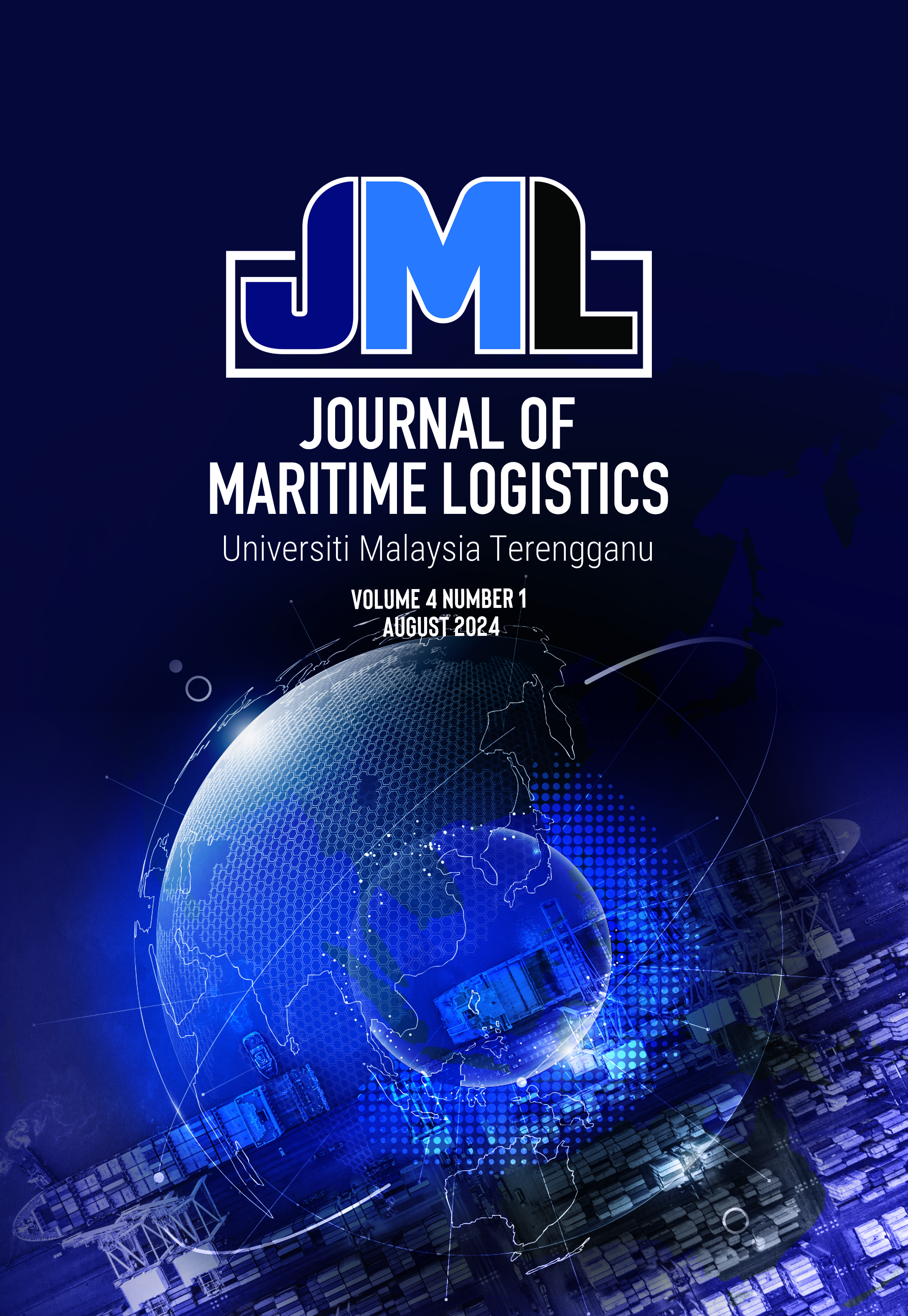OPTIMISING SAFETY: INVESTIGATING THE NEXUS OF SAFETY MANAGEMENT, SAFETY CLIMATE AND SAFETY PERFORMANCE IN MALAYSIAN LOGISTICS COMPANIES
DOI:
https://doi.org/10.46754/jml.2024.08.002Keywords:
Safety Performance, Safety Climate, Safety Management Practices, LogisticsAbstract
Safety Management can be defined as the imperative of safety operations within the dynamic landscape of the logistics sector. It underscores the focal point of addressing workplace safety issues, highlighting a deficiency in comprehension of safety practices as a root cause for safety performance challenges. Remarkably, logistic companies exhibit a visible deficiency in the adoption of vigorous safety management practices, while worker perceptions suggest suboptimal efficacy of the safety climate. Methodologically, a quantitative research approach is used, utilizing a survey distributed via email and Google Forms, with 107 respondents comprising operators and truck drivers from various logistics companies in Malaysia. Analysis is conducted utilizing IBM Statistical Package for Social Sciences (SPSS) version 29, with reliability, validity, and normality analyses used to scrutinize the relationship between variables. Regression analysis reveals a statistically significant association between safety performance, safety management practices, and safety climate at a significance level of 0.001. The study portrays a positive correlation between an affirmative safety climate and enhanced safety performance within Malaysian logistic companies. It emphasizes the cultivation of a safety-conscious organizational culture as vital, fostering a proactive stance that mitigates accidents and enhances overall safety outcomes. Strategic interventions aimed at strengthening the safety climate emerge as instrumental in extending safety excellence within Malaysia's logistics operations.References
Auyong, H.-N., Zailani, S., & Surienty, L. (2016). Perceived safety management practices in the logistics sector. Work, 53(4), 729-735. https://doi.org/10.3233/ wor-162272 DOI: https://doi.org/10.3233/WOR-162272
Han, B., Son, S., & Kim, S. (2021). Measuring safety climate in the construction industry: A systematic literature review. Sustainability, 13(19), Article 10603. https://doi.org/10.3390/su131910603 DOI: https://doi.org/10.3390/su131910603
Kim, S., Kim, P. B., & Lee, G. (2021). Predicting hospitality employees’ safety performance behaviors in the COVID-19 pandemic. International Journal of Hospitality Management, 93, Article 102797. https:// doi.org/10.1016/j.ijhm.2020.102797 DOI: https://doi.org/10.1016/j.ijhm.2020.102797
Naji, G. M. A., Isha, A. S. N., Mohyaldinn, M. E., Leka, S., Saleem, M. S., Rahman, S. M. N. B. S. A., & Alzoraiki, M. (2021). Impact of safety culture on safety performance; mediating role of psychosocial hazard: An integrated modelling approach. International Journal of Environmental Research and Public Health, 18(16), Article 8568. https://doi.org/10.3390/ ijerph18168568 DOI: https://doi.org/10.3390/ijerph18168568
Noor Arzahan, I. S., Ismail, Z., & Yasin, S. M. (2022). Safety culture, safety climate, and safety performance in healthcare facilities: A systematic review. Safety Science, 147, Article 105624. https://doi.org/10.1016/j. ssci.2021.105624 DOI: https://doi.org/10.1016/j.ssci.2021.105624
Probst, T. M., Goldenhar, L. M., Byrd, J. L., & Betit, E. (2019). The Safety Climate Assessment Tool (S-CAT): A rubric-based approach to measuring construction safety climate. Journal of Safety Research, 69, 43-51. https://doi.org/10.1016/j. jsr.2019.02.004 DOI: https://doi.org/10.1016/j.jsr.2019.02.004
Shaikh, A. Y., Osei‐Kyei, R., & Hardie, M. (2020). A critical analysis of safety performance indicators in construction. International Journal of Building Pathology and Adaptation, 39(3), 547-580. https://doi. org/10.1108/ijbpa-03-2020-0018 DOI: https://doi.org/10.1108/IJBPA-03-2020-0018
Shea, T., De Cieri, H., Vu, T., & Pettit, T. (2021). How is safety climate measured? A review and evaluation. Safety Science, 143, Article 105413. https://doi.org/10.1016/j. ssci.2021.105413 DOI: https://doi.org/10.1016/j.ssci.2021.105413
Sultana, S., Andersen, B. S., & Haugen, S. (2019). Identifying safety indicators for safety performance measurement using a system engineering approach. Process Safety and Environmental Protection, 128, 107-120. https://doi.org/10.1016/j. psep.2019.05.047 DOI: https://doi.org/10.1016/j.psep.2019.05.047
Vu, T.-V., Vo-Thanh, T., Nguyen, N. P., Nguyen, D. V., & Chi, H. (2022). The COVID-19 pandemic: Workplace safety management practices, job insecurity, and employees’ organizational citizenship behaviour. Safety Science, 145, Article 105527. https://doi. org/10.1016/j.ssci.2021.105527 DOI: https://doi.org/10.1016/j.ssci.2021.105527
Wagner, A., Rieger, M. A., Manser, T., Sturm, H., Hardt, J., Martus, P., Lessing, C., & Hammer, A. (2019). Healthcare professionals’ perspectives on working conditions, leadership, and safety climate: A cross-sectional study. BMC Health Services Research, 19(1). https://doi.org/10.1186/ s12913-018-3862-7 DOI: https://doi.org/10.1186/s12913-018-3862-7
Wong, T. K. M., Man, S. S., & Chan, A. H. S. (2020). Critical factors for the use or non-use of personal protective equipment amongst construction workers. Safety Science, 126, Article 104663. https://doi.org/10.1016/j. ssci.2020.104663 DOI: https://doi.org/10.1016/j.ssci.2020.104663
Wong, T. K. M., Man, S. S., & Chan, A. H. S. (2021). Exploring the acceptance of PPE by construction workers: An extension of the technology acceptance model with safety management practices and safety consciousness. Safety Science, 139, Article 105239. https://doi.org/10.1016/j. ssci.2021.1052 DOI: https://doi.org/10.1016/j.ssci.2021.105239
Downloads
Published
How to Cite
Issue
Section
License
Copyright (c) 2024 Journal of Maritime Logistics

This work is licensed under a Creative Commons Attribution 4.0 International License.









